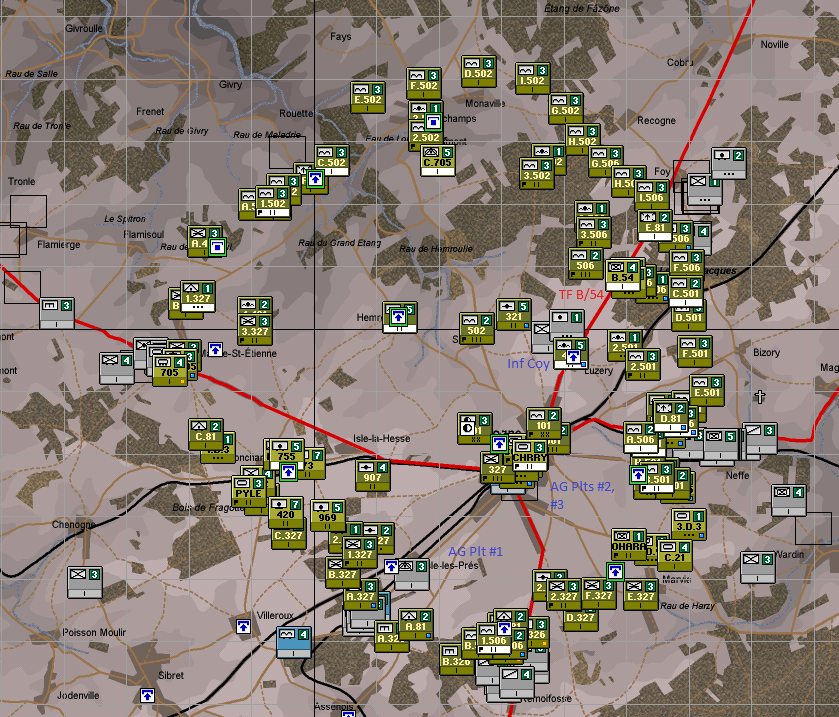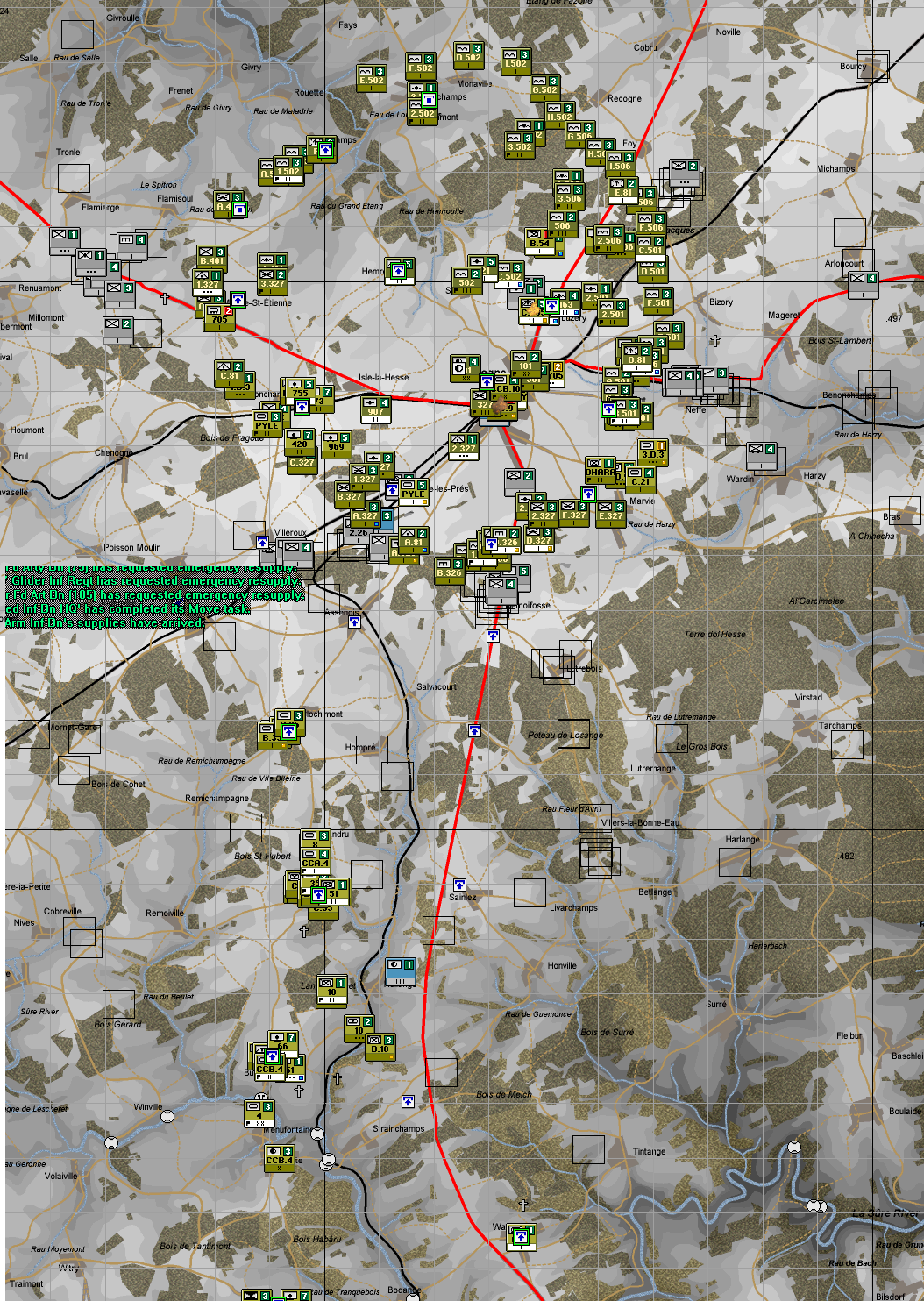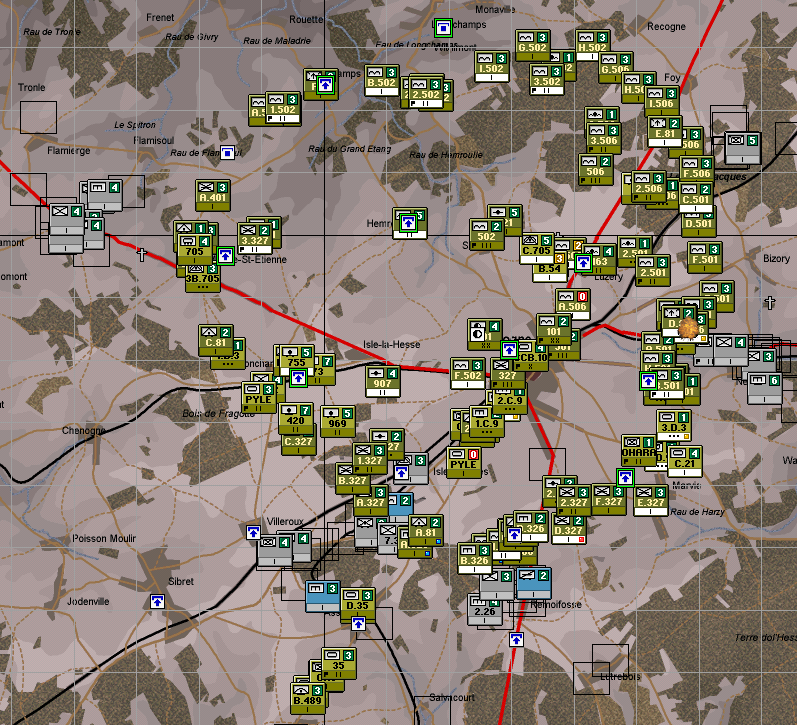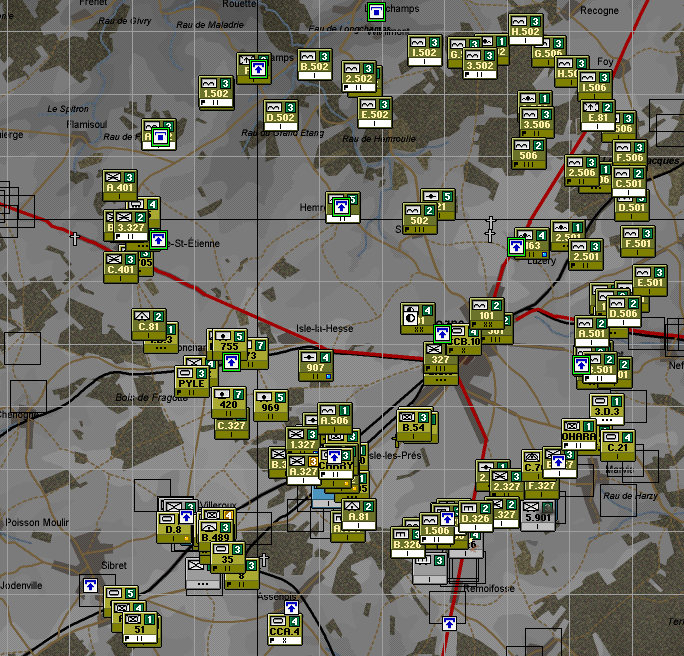December 24, 1944
On the 24th, Patton sent McAuliffe a radio message: “Xmas Eve present coming up. Hold on.”
This was an example of Patton’s grandstanding more than his success as a commander: it took CCA until midday on the 24th to get past Warnach, and CCB was still bogged down between Chaumont and Clochimont. Christmas Eve passed without relief for the defenders of Bastogne.
Early in the evening, as McAuliffe was walking past the police station, he heard German prisoners inside singing carols. He paused to listen: “Stille nacht,” “O Tannenbaum.” On an impulse, McAuliffe went inside. “We’ll be in Antwerp in a few weeks,” shouted one of the prisoners in English. “We’ll seen be freed,” shouted another, “and it is you who will be the prisoner.” And still another: “You’ll like it there, General; it is most comfortable and cozy.”McAuliffe waited for them to quiet down. He had come by, he said at last, to wish them all a Merry Christmas.
The defenders of Bastogne matched the stubbornness displayed by the German paratroopers in stalling the 4th Armored Division’s advance, and at the end of the day the lines had not changed significantly. Most critically, General Gaffey ordered the 4th Armored’s CCR to attack along the Neufchâteau highway.
That night, in preparation for a major attack on Christmas Day, the Germans launched a bombing raid against Bastogne:
Inside Bastogne, around eighty thirty on Christmas Eve, men heard the approaching drone of a swarm of big planes, their motors throbbing in a manner uncharacteristic of American planes. For almost all the Americans in the tow, the bombing was a new and terrifying experience. First came magnesium flares that made the night seem brighter than day and anybody caught in the open feel naked; then the bombs.In two runs over Bastogne, German bombers, most of them Junkers 88s, dropped approximately 2 tons of bombs, low in terms of what American bombers usually delivered (seldom less than 20 tons), but enough to do heavy damage to a town the size of Bastogne. […] A town that had hardly been touched earlier in the war at that point “wore that ghastly air of desolation” that had come to so many other places in Europe.
—
My alternate-history 24th was not nearly so uneventful. By daylight, the bulk of the 4th Armored Division’s CCA took Chaumont, though the headquarters elements were delayed on the Arlon highway east of Burnon. I redirected the 10th Armored Infantry Battalion to attack to give CCA’s headquarters a safe route up to Chaumont, where it could direct an attack on Clochimont.

Overnight, I’d had an inkling that some German units had managed to infiltrate through the leakier line to Bastogne’s north and at two under-defended points in the southwest and southeast. Only when daylight came did I realize how bad it was: a company of infantry and an attached mortar platoon had snuck past the lines in the north, and threatened the 321st and 463rd Parachute Artillery Battalions between Luzery and Savy, a mile north of Bastogne. Two assault gun companies were spotted in Bastogne itself, and a third had broken through the lines of the 327th Glider Infantry Regiment’s 1st Battalion, and sat in Iles-les-Prés directing accurate and deadly fire at any tanks that came near.

Fortunately, overnight I’d formed a new task force from reserve elements of Team O’Hara: B Company of the 54th Armored Infantry Battalion, along with the 54th Armored Infantry’s mortar and assault gun platoons. I’d also recalled Team Cherry from its defensive post on the northwest of the perimeter, and pulled D Battery of the 81st Airborne AA Battalion and C Company of the 705th Tank Destroyer Battalion off of the northeast perimeter. I held all of those in reserve in or around the town center, so when daylight hit, they were well-placed to start on the process of evicting the Germans inside the perimeter. Task Force B/54 moved to eliminate the infantry and mortar company, while Team Cherry plus a platoon of tank destroyers cleared out an assault gun platoon from Bastogne by afternoon. The other had retreated south, and spent most of the day lobbing fire to the west.
By noon, elements of the 4th Armored’s CCA had reached Clochimont, only three miles from the Bastogne perimeter, along with the 10th Armored Infantry Battalion and the 8th Tank Battalion. Headquarters units of the 4th Armored and of CCA and CCB held Chaumont and Burnon.

Team Pyle’s tank company, which you can see in the screenshot above behind the German assault gun company in the vicinity of Iles-les-Prés, spent most of the day getting hammered by crossfire from the other assault gun company, and was eliminated by nightfall. The German assault gun platoon south of Bastogne proper attempted to retreat toward Remoifosse, but was forced to surrender by engineers there, and Task Force B/54, plus C Company, 705th TD Battalion and A Company, 506th Parachute Infantry Regiment had cleared out the German infantry, leaving only the assault gun platoon that had penetrated from Villeroux inside the perimeter. Team Cherry attacked to close that gap. By twilight, the leading elements of the 35th Tank Battalion had reached Assenois, less than a mile from the Bastogne perimeter, and prepared for an attack to the west to relieve the pressure on the 1st Battalion, 327th Glider Infantry Regiment.
I had originally intended the 318th Infantry Regiment to hold critical road junctions to the south to keep supply lines open, but the situation in Bastogne has been sufficiently critical all day that I decided to send the 2nd Battalion along the road into Bastogne from Assenois to reinforce the defense. The 1st Battalion would go on to guard the flank at Clochimont.

As evening settled in over Bastogne, the town had taken heavy attacks through the whole day, from Villeroux, Remoifosse, and Neffe. In an effort to find more reserves to commit against the incursions from Neffe and Villeroux, I bent the line in the north down into a straighter line, which let me pull two companies from the 2nd Battalion, 502nd Parachute Infantry Regiment.
Midnight arrived with the situation vastly improved. The northwest perimeter featured a large gap between the 1st Battalion, 502nd Parachute Infantry Regiment and the 3rd Battalion, 327th Glider Infantry Regiment, but attached to the 3/327 were an armored car company and C Company, 705th TD Battalion, either or both of which I could detach to use as a mobile reserve. Team Cherry had reached the perimeter and was effectively plugging the gap, while CCA’s attack on Villeroux gained the edge of the town. The 51st Armored Infantry Battalion, operating detached, was marching on Sibret but had not yet seen any opposition. Just south of this picture, the 2nd Battalion, 318th Armored Infantry, was on the way from Clochimont to Bastogne via Assenois.

—
In my version of events, the Germans employed a vastly different strategy to the plan they employed in reality. My Bastogne has experienced heavy attacks almost non-stop at three points, and the infiltration overnight forced me to stretch the troops in Bastogne far more than I was comfortable doing so. I reached Bastogne on the night of the 24th rather than the early morning of the 26th, making good on Patton’s ill-advised promise, but the road to Bastogne was practically undefended. Nearly every unit the Germans could spare was attacking Bastogne.
Last night, Matrix released the Command Ops patch, an effort for which I retract most of my earlier steamedness. Unfortunately, I doubt it’s save-game compatible, so I’ll have to finish this with the halting bug.



